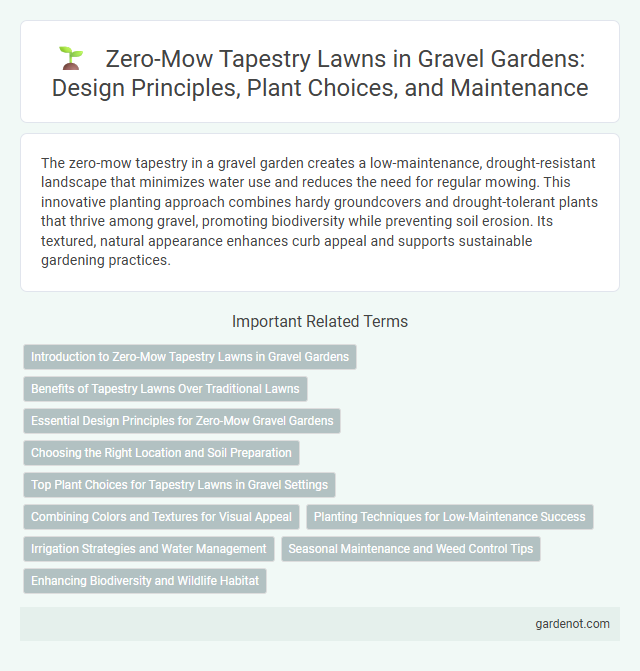The zero-mow tapestry in a gravel garden creates a low-maintenance, drought-resistant landscape that minimizes water use and reduces the need for regular mowing. This innovative planting approach combines hardy groundcovers and drought-tolerant plants that thrive among gravel, promoting biodiversity while preventing soil erosion. Its textured, natural appearance enhances curb appeal and supports sustainable gardening practices.
Introduction to Zero-Mow Tapestry Lawns in Gravel Gardens
Zero-Mow Tapestry lawns integrate low-growing wildflowers and fine grasses to create a resilient, low-maintenance ground cover ideal for gravel gardens. These lawns reduce the need for mowing and irrigation while promoting biodiversity and soil health. Incorporating drought-tolerant species ensures year-round visual interest and environmental benefits in arid garden settings.
Benefits of Tapestry Lawns Over Traditional Lawns
Zero-mow tapestry lawns significantly reduce maintenance by eliminating regular mowing, saving time and energy. These low-growing, drought-tolerant plants promote biodiversity by providing habitats for pollinators and beneficial insects within gravel garden settings. Their deep root systems improve soil structure and water retention, making them an eco-friendly alternative to traditional turfgrass lawns.
Essential Design Principles for Zero-Mow Gravel Gardens
Zero-mow tapestry gravel gardens prioritize drought-tolerant, low-maintenance plants like sedums and creeping thyme, which thrive without frequent mowing. Proper soil preparation with well-draining substrates ensures healthy root growth and prevents waterlogging. Strategic plant spacing and layering create an aesthetically pleasing, sustainable gravel garden that reduces maintenance and supports biodiversity.
Choosing the Right Location and Soil Preparation
Selecting a well-drained, sunny spot is essential for establishing a thriving Zero-mow tapestry in a gravel garden. Preparing the soil involves removing weeds, loosening the substrate, and incorporating organic matter or sand to enhance drainage and nutrient retention. Proper site selection and soil preparation promote healthy root development and reduce maintenance needs in low-growing, drought-resistant plant mats.
Top Plant Choices for Tapestry Lawns in Gravel Settings
Top plant choices for zero-mow tapestry lawns in gravel settings include drought-tolerant species like Creeping Thyme (Thymus serpyllum), which thrives in well-drained soils and produces vibrant purple flowers. Other excellent options are Irish Moss (Sagina subulata) for its dense, mossy texture and Woolly Yarrow (Achillea tomentosa), known for its yellow blooms and resilience. These low-maintenance plants reduce mowing needs while enhancing gravel garden aesthetics with their varied textures and colors.
Combining Colors and Textures for Visual Appeal
Zero-mow tapestry in gravel gardens enhances visual appeal by combining diverse colors and textures, creating a natural yet low-maintenance landscape. Incorporating gray, green, and blue hues from drought-tolerant plants alongside contrasting gravel stones produces a dynamic aesthetic. Textural variation from smooth gravel and coarse foliage adds depth, promoting a balanced and harmonious garden design.
Planting Techniques for Low-Maintenance Success
Zero-mow tapestry planting techniques emphasize selecting drought-tolerant, native species with deep root systems that stabilize soil and reduce erosion in gravel gardens. Layering low-growing groundcovers and flowering perennials creates a dense, self-sustaining carpet that suppresses weed growth and requires minimal watering. Strategic spacing and soil preparation improve drainage and nutrient retention, ensuring long-term health and visual appeal with little maintenance.
Irrigation Strategies and Water Management
Zero-mow tapestry in gravel gardens requires precise irrigation strategies to optimize water retention and minimize runoff. Employing drip irrigation systems ensures targeted hydration directly to plant roots, reducing evaporation and water waste. Integrating moisture sensors can further enhance water management by delivering irrigation only when soil moisture levels drop below the optimal threshold.
Seasonal Maintenance and Weed Control Tips
Zero-mow tapestry in gravel gardens reduces the need for frequent mowing, offering a low-maintenance ground cover that thrives with minimal intervention. Seasonal maintenance involves checking for debris and pruning any overgrown patches during early spring and late autumn to promote healthy growth and airflow. Effective weed control relies on early detection, manual removal, and the application of eco-friendly herbicides to prevent invasive species from disrupting the gravel garden ecosystem.
Enhancing Biodiversity and Wildlife Habitat
Zero-mow tapestry in gravel gardens promotes enhancing biodiversity by supporting diverse native plant species that attract pollinators such as bees and butterflies. This low-maintenance ground cover creates essential habitats for beneficial insects, small mammals, and birds, contributing to a balanced urban ecosystem. Its porous structure improves soil health and water infiltration, fostering a sustainable environment for wildlife to thrive.
Zero-mow tapestry Infographic

 gardenot.com
gardenot.com